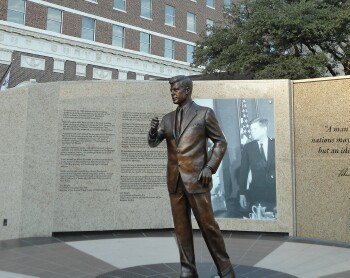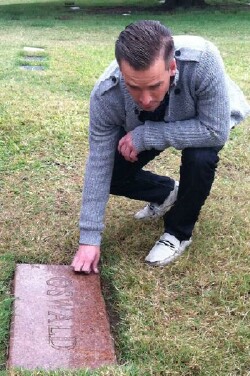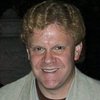Inside National Geographic Channel's One of a Kind Press Event for "Killing Kennedy" -- Ed Martin

Last month, in one of the most extraordinary moments of my career as a writer covering television, I stood at the grave of Lee Harvey Oswald on what would have been his 74th birthday with the actor who portrays him in the upcoming National Geographic Channel original movie “Killing Kennedy.” It was a moment best described as meta, to use a currently popular term.
The cemetery visit was one of many mesmerizing stops on a consistently fascinating press tour Nat Geo put together last month in Fort Worth and Dallas to provide critical insight into the making of the channel’s two big programs marking the 50th anniversary of the assassination of President John F. Kennedy on November 22, 1963: The documentary “JFK: The Final Hours” and “Killing Kennedy,” arguably the most important made-for-television movie in the network’s history.
Nat Geo put together last month in Fort Worth and Dallas to provide critical insight into the making of the channel’s two big programs marking the 50th anniversary of the assassination of President John F. Kennedy on November 22, 1963: The documentary “JFK: The Final Hours” and “Killing Kennedy,” arguably the most important made-for-television movie in the network’s history.
November 22 won’t only mark the 50th anniversary of the assassination of President Kennedy. It is also the anniversary of the first giant news event covered in wall-to-wall fashion by television, which was still a very young medium at the time. From the afternoon of November 22 when Walter Cronkite first announced to the nation that President Kennedy had died, to the Sunday morning when families gathered around their black and white TV sets after church to resume watching the ongoing coverage and were horrified to witness Jack Ruby murder Oswald right before their eyes, to the historic funeral procession on Monday afternoon in Washington D.C. that was punctuated by a three-year-old John F. Kennedy Jr. saluting as his father’s coffin passed in front of him, this was for most Americans a four-day live television event that was enthralling in the worst possible way. It literally seemed to simultaneously stop and change the world; something that wouldn’t happen again until the terrorist attacks in New York, Washington D.C. and Pennsylvania on September 11, 2001.
National Geographic assembled dozens of journalists from around the country and overseas for this one of a kind event. Guests stayed at the Hilton Fort Worth, the very same hotel (then known as the Hotel Texas) that the Kennedys stayed at during what would be the last night of the President’s life. There is a beautiful memorial directly in front of the hotel on the very spot where he spoke to thousands of people on the morning of November 22 who had assembled during what had been a rainy night hoping to catch even a glimpse of the Kennedys. When I arrived at the hotel and saw the memorial (pictured above), which features a striking bronze statue of JFK, images from his time in Fort Worth and a waterfall, I thought I was seeing something that had been in place for decades. Oddly, it has only been there for just over a year.
A screening of “JFK: The Final Hours” opened the tour the night of October 17 in the hotel’s Crystal Ballroom, where Kennedy would enjoy his final meal and make his last speech (to the Fort Worth Chamber of Commerce) on November 22. Among the guests from the documentary that attended the screening was Buell Frazier, a co-worker of Oswald’s who drove him to his job at the Texas School Book Depository on the morning of November 22, unaware that the object wrapped in brown paper that Oswald had placed in the back seat of his car was the rifle that would later be used to murder the President.
October 18 began with a near-recreation of Kennedy’s final meal (with poached eggs substituted for the hard-boiled kind, which Kennedy preferred), again in the hotel’s Crystal Ballroom. The group then traveled to the Amon Carter Museum of American Art in Fort Worth to see a special exhibition titled “Hotel Texas: An Art Exhibit for the President and Mrs. John F. Kennedy” comprised of the many paintings, drawings and sculptures that had been assembled by a woman named Ruth Carter Stevenson and a group of Fort Worth art collectors to decorate the Kennedys’ suite at the Hotel Texas during their stay on the night of November 21. It was an impressive exhibit, even if the two centerpieces of the quickly orchestrated hotel room collection – Claude Monet’s “Portrait of the Artist’s Granddaughter” (1876-77) and Vincent Van Gogh’s “Road with a Peasant Shouldering a Spade” (1887) – were not part of the show.
After the museum visit the meta aspect of the tour truly kicked in. We set off by bus on the Oswald portion of the event, stopping first at his modest gravestone in the Rosehill Cemetery in the southeast corner of Fort Worth. Being there on Oswald’s birthday was one thing. Being there with Will Rothhaar (above right), the actor who portrays Oswald in “Killing Kennedy” and will likely be very well known once the film is telecast, was quite another. Hauntingly, someone had left a bouquet of flowers that morning on Oswald’s grave.
We also stopped at the former home of Ruth Paine, the woman Oswald’s wife was staying with when they separated, where Oswald spent the night of November 21; the boarding house where Oswald posed for the infamous “backyard” photographs in which he is holding the rifle he would use to murder the President, and the garage entrance area of the Municipal Building in downtown Dallas where Jack Ruby murdered Oswald live on television on the morning of November 24. Then we rode the same route that the Kennedy entourage took on November 22 en route to what would have been a speech in Dallas at the Trade Mart (a consumer products showroom), stopping at Dealey Plaza outside the Texas School Book Depository to closely study the scene of the assassination. Two large white X marks on Elm Street, the road that runs alongside the legendary grassy knoll, indicate the exact spots where two of the three shots that were fired struck the President.
Following our time at Dealey Plaza we made the short drive to the historic Texas Theatre for the world premiere of “Killing Kennedy.” The Texas Theatre, which is now a successful art house (perhaps because it now boasts a well-stocked martini bar), is the location where police apprehended Oswald on the afternoon of November 22. The seat Oswald was in when fifteen officers stormed the theater was clearly marked.
After the movie we returned to Dealey Plaza for dinner in the Texas School Book Depository – another in a series of major meta moments that day. The sixth and seventh floors are now a museum open to the public. The far right window on the sixth floor in the front of the building – now sectioned off behind glass partitions – is the spot where Oswald fired the shots that would change the world. Standing right next to it and looking out at the white X marks on Elm Street was a chilling experience I will never forget.
Check us out on Facebook at MediaBizBloggers.com
Follow our Twitter updates @MediaBizBlogger
The opinions and points of view expressed in this commentary are exclusively the views of the author and do not necessarily represent the views of MediaBizBloggers.com management or associated bloggers. MediaBizBloggers is an open thought leadership platform and readers may share their comments and opinions in response to all commentaries.


